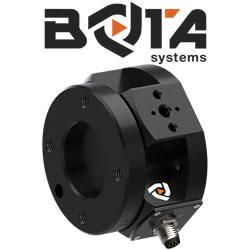AMREL Robotic Interoperability Breakthrough
AMREL recently demonstrated an important breakthrough in interoperability for unmanned systems.
EL MONTE, CA - AMREL recently demonstrated an important breakthrough in interoperability for unmanned systems. At the Robotics Rodeo held at Fort Benning, Georgia, during October, AMREL successfully used the same payload controller to operate two different Unmanned Ground Vehicles (UGVs).
"Actually, if you count humans, we used the same payload controller on three vehicles, not two," joked Michael Castillo, Senior Robotics Architect for AMREL. "Integrated into the payload controller were sensor packages that can also operate as independent handheld devices."
As David Rowe and David Bruemmer (CEO and VP of 5D™ Robotics, respectively) described it, "...the kit becomes no longer just a robot payload, but a stand-alone intelligent node that can be used as an unattended ground sensor, that can be hand held by a soldier, and that can snap onto and control multiple robots."
At the Robotics Rodeo, industry and military observers were surprised at the ease with which the payload controller prototype was moved from the Segway RMP 50 to the Segway RMP 400. Within seconds, the operator successfully transferred control and full sensor capability from one robot to another. While the Department of Defense (DoD) has sought this type of interoperability, AMREL's payload controller prototype is the first to demonstrate it.
Although this is AMREL's first payload controller, it is the leading supplier of Operator Control Units (OCUs) for unmanned systems. In fact, so many vendors used AMREL OCUs at the Robotics Rodeo, that one participant remarked that it "looked like an AMREL warehouse."
Each hardware element of the controller has a mature TR rating of 9. Components include:
Sensor packages (ICx Technologies Fido and RAE Systems Sensor Array)
Antenna Products radios
AMREL's DR8 8-inch tablet
The DR8 tablet, like all AMREL's rugged computers, is modular, which enables the easy-to-use "snap-on" capability of the payload controller. The AMREL tablet used in the prototype was a Commercial-Off-The-Shelf product (COTS) that required only minor modifications.
5D™ Robotics software functioned as interoperable middleware. It facilitates integration with virtually any sensor system or Operating System (OS), without exposing or interfering with the underlying proprietary software. It can even act as an independent OS itself. DeVivo AST ensured compliance with JAUS, the DoD standards for software interoperability.
"With this payload controller, integration is amazingly simple," explains Mr. Castillo. "If you want to add a sensor, just use a flash drive to download the driver through the USB port of our tablet. That's it."
To learn more about AMREL's pioneering efforts in interoperability, visit www.commoncontrolnow.com/Flexkit.asp.
ABOUT AMREL
American Reliance Inc. (AMREL) designs and manufactures small-footprint, highly integrated, rugged mobile computing solutions for OCUs. Quickly and easily modified, a single OCU can command and control a wide array of Unmanned Systems.
Featured Product

Bota Systems - The SensONE 6-axis force torque sensor for robots
Our Bota Systems force torque sensors, like the SensONE, are designed for collaborative and industrial robots. It enables human machine interaction, provides force, vision and inertia data and offers "plug and work" foll all platforms. The compact design is dustproof and water-resistant. The ISO 9409-1-50-4-M6 mounting flange makes integrating the SensONE sensor with robots extremely easy.
No adapter is needed, only fasteners! The SensONE sensor is a one of its kind product and the best solution for force feedback applications and collaborative robots at its price. The SensONE is available in two communication options and includes software integration with TwinCAT, ROS, LabVIEW and MATLAB®.
